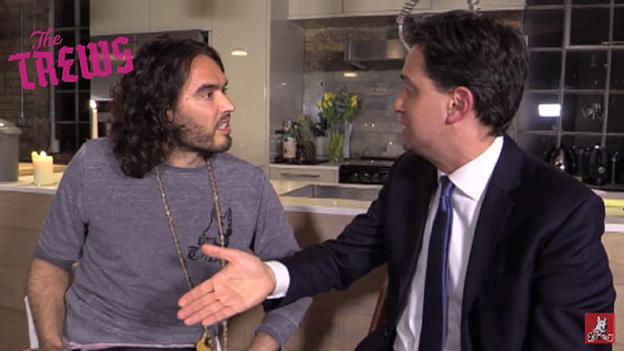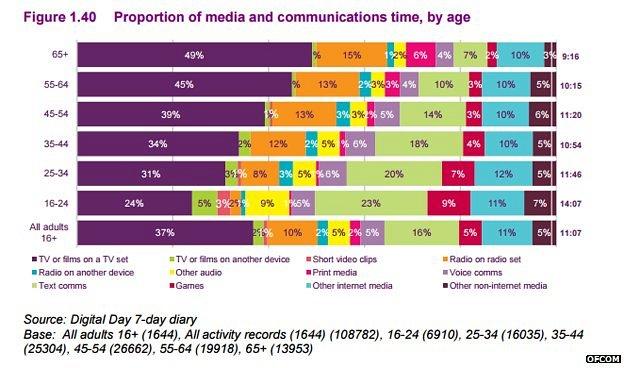Brand/Miliband: Is this the real start of the 'social media election'?
- Published
- comments

Was Ed Miliband right or wrong to agree to an interview for Russell Brand's YouTube channel?
I'll let you be the judge of that, but the strategy seems clear - reach an audience of young people who are more likely to watch online video and share news on Facebook than tune in to TV news or read a newspaper.
But is it true that the media habits of the young are so very different from those of older voters? There's a lot of anecdotal evidence ("I never watch anything but YouTube ", "Only sad old people actually read a paper") but finding real data from respectable sources is harder.
Deep in Ofcom's 2014 Communications Market Report, external, however, is a useful graphic which charts the time spent on media and communications by age group. What it shows is that 16 to 24-year-olds still spend a lot of time watching live television, but it's declining and is substantially less than that of older people.

Still, 24% of their communications time is devoted to live TV, with just 3% spent on "short video clips" which I suspect means YouTube. But the figures show their radio listening has gone into steep decline, and time spent on print media is vanishingly small. What's more, they are spending lots of their time on messaging, gaming and social networking - areas where you might think the big old media brands were less powerful.
A rather different picture emerges from the Reuters Institute Digital News Report, external. It has good tidings for national newspapers, particularly those that have adapted quickly to the online world. The report says that despite their high level of TV viewing, more 18 to 24-year-olds in the UK read newspapers in some format than watch TV news.
It also says that even the print versions of newspapers reach 51% of 18 to 24-year-olds each week. That feels extraordinarily high, and the term "reach" sounds nebulous, but I'm told that it means they have read at least one edition of the paper. So it does look as though the picture often painted of young people getting all their entertainment and news from their smartphones and ignoring the traditional media is an exaggerated one.
Nevertheless, their habits are changing, and fast. YouTube is attracting audiences that would be the envy of many specialist news programmes, and Facebook is also becoming the place many share and view video. Comscore has sent me figures showing that 16 to 24-year-olds spent 491.5 minutes in March watching YouTube on their desktop computers. Bear in mind that they will still have spent many hours more watching traditional TV, but then factor in the additional time staring at videos on their phones.
Until now, the promised social media election has failed to materialise, with the big stories starting in the newspapers and on television, and then being commented on by Facebook and Twitter users. The Brand/Miliband interview is the first story to reverse that trend. The last time I looked, the trailer for his Miliband interview had nearly a quarter of a million views on Brand's YouTube channel, which has a million subscribers, so the full version should attract a much bigger audience.
Mind you, I've just spotted another YouTube channel with a far bigger audience. Zoella, the makeup artist, has more than eight million subscribers who've viewed her videos more than 400 million times. Maybe the politicians should be beating a path to her door…